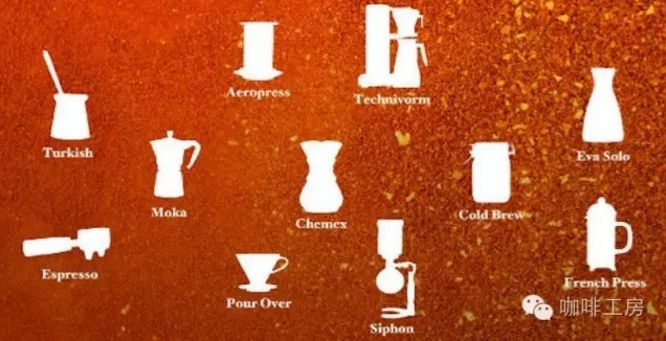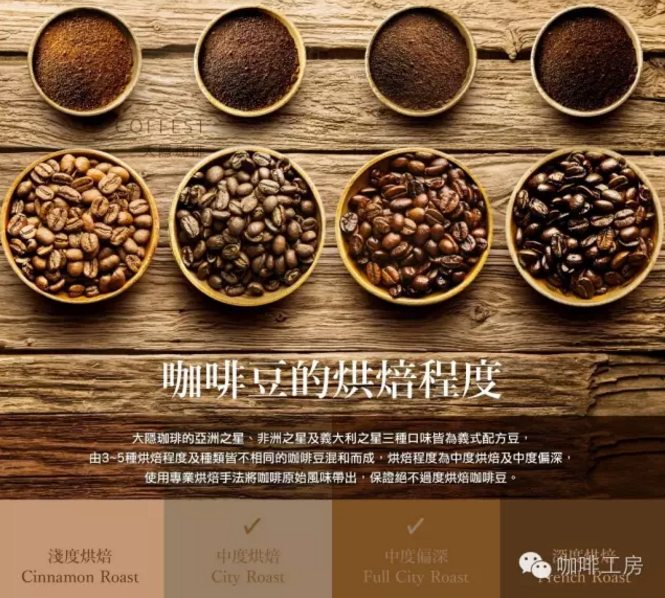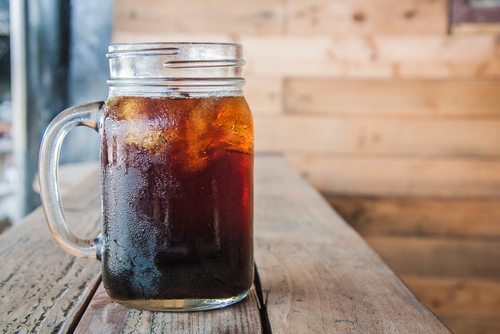popular science| How do you taste all that stuff in coffee? About the cup test.

For professional baristas, please follow the coffee workshop (Wechat official account cafe_style)
Although we often see the flavor description of coffee beans.
But there are still people who look at a loss.
What the heck are these smells?
What the heck is the cup test?
So...
Let's talk today.
Those things about the cup test.
When testing a cup of coffee, we should distinguish whether the flavor, alcohol thickness, acidity and wet aroma of the coffee are pleasant. Most cup tasters use the following criteria to judge coffee:
Acidity: acidity is an essential feature of coffee and is the feeling of dryness produced by coffee at the edge of the tongue and the back of the palate. The effect of coffee acidity is similar to that of red wine, with a strong and exciting texture. Without enough acidity, the coffee tends to be flat. The wet aroma is difficult to separate from the flavor. If there is no sense of smell, our basic sense of taste is only sweet, sour, salty and bitter. The wet aroma enriches the taste discrimination of the soft palate. Some subtle and delicate differences, such as the "floral" or "wine" characteristics, come from the wet aroma of brewed coffee.
Alcohol thickness: the feeling of coffee in the mouth, that is, the feeling of stickiness, thickness and richness produced by coffee acting on the tongue. The difference between drinking whole milk and drinking water is a good example. Our perception of the alcohol thickness of coffee is related to the oil and solids extracted by coffee. The alcohol thickness of Indonesian coffee is significantly higher than that of South and Central American coffee. If you are not sure about the alcohol thickness difference of several types of coffee, try adding the same amount of milk to the coffee. Coffee with high alcohol thickness will retain more flavor when diluted with milk.
Flavor: it is the overall feeling of coffee in the mouth.
Typical flavor characteristics
Richness-refers to the thickness and richness of alcohol
Complexity-the feeling of multiple flavors
Balance-all basic taste features are satisfactory
No one taste masks another.
All the color, aroma and taste of coffee are characterized by chemical changes in the raw beans of coffee after the roasting process.
Flavor characteristics in flavor wheel:
Pleasing flavor features:
Caramel-like sugar or syrup
Chocolate-like unsweetened chocolate or vanilla aftertaste
Delicious-delicate flavor felt on the tip of the tongue (Arabica beans from New Guinea)
Earthy-the aroma of the earth (typical Sumatran coffee)
Fragrant-an aromatic quality, ranging from floral to spicy
Fruity-an aromatic quality reminiscent of berries or oranges
Sweet and mellow-round, smooth, lack of acidity
Nutty-- similar to the aftertaste of fried nuts
Spicy-reminiscent of the flavor and aroma of various spices
Sweet-- non-astringent
Wild-A wild flavor that is generally not considered pleasant (common in Ethiopian coffee)
Alcoholic aroma-an aftertaste reminiscent of fully ripe wines (common in Kenyan and Yemeni coffee).
An unpleasant flavor feature:
Bitter-A taste produced at the root of the tongue, often caused by overbaking
Dull, non-irritating-neutral in flavor
Charcoal-smelling of charred carbon
Inanimate-- same as "Flat"
Mixed-smelling-musty, reminiscent of the taste of eating dirt
Earthy-- with "mixed smell"
Insipid-no sour taste, lack of wet fragrance and aftertaste
Grassy-reminiscent of freshly cut grass
Rough-- a harsh, catch-like, rough quality
Muddy-sticky but not strong in taste
Stiff-starch resembles texture, similar to water cooked with pasta
Rough-the feeling on the tongue, similar to eating salt
Rubber smell-similar to the smell of burnt rubber (commonly found in dry processed robusta beans)
Soft-the same as "boring, non-irritating"
Sour-similar to the sour taste of unripe fruit
Thin-acidity-free, usually caused by insufficient extraction
Turpentine-- tastes like turpentine.
Water-like-lack of alcohol thickness and stickiness in the mouth
Rough-wild quality.
Overall, sweetness does have a great effect on coffee, which can also be confirmed by the CoE (Cup of Excellence) cup meter.
This is a cup meter designed to "find the best coffee from a pile of good coffee". The whole table is developed around the two main axes of sweetness Sweet and cleanliness Clean Cup, and the test items are strongly related to each other.
The higher the altitude, the sweeter the beans, as long as they are roasted properly, they will show elegant and smooth acid Acidity and taste Mouth Feel, and of course the sweet and varied aroma will be caught by the nose. Under this series of interrelated testing items, only sweetness and cleanliness can run through the whole audience. So going back to the origin, the concept of how to maximize sweetness, match sour and salty tastes, and finally control bitterness applies not only to coffee, but also to other foods.
In addition, from the point of view of baking and cup testing, sour and sweet are really indispensable. The higher the altitude of raw beans, the higher the sucrose content, the better the acid quality, and of course, the higher the sucrose content, the sweeter it is, which means that after baking, there is a chance to produce more fatty acids to increase aroma and flavor.
With the sweet taste, the acidity will be softer and the Body will be round and smooth. If there is only sweet but not sour, it also makes the coffee lose its liveliness and brightness. Finally, the taste balance of coffee is not uniform, but a kind of matching aesthetics. This not only affects the drinking experience of consumers, but also an important issue that bakers have to face.
The salty taste of coffee
There are also many kinds of salty taste, and the aroma reminds people of saltier foods, such as the smell of too much salt in fried food, and the smell of the bottom of the cup after drinking coffee, which smells salty, reminiscent of salty snacks like Wangxianbei, and so on. And the taste summed up is the taste of salt.
The salty taste of coffee mainly comes from minerals, which are not reduced by roasting. On the contrary, the content of sucrose in fresh coffee raw beans accounts for about 6% to 9% (depending on altitude), which is also the largest source of coffee sweetness. The poor storage of raw beans and improper roasting not only make the coffee lose its sweetness, but also make the acid irritating and unpleasant. After losing the balance of sweetness, it will highlight the salty and sour taste, and if the baker does not notice for a moment, deliberately grinding sour in order to modify the acerbic displeasure, it will only make the coffee more salty and bitter.
Usually do hand flushing and Italian style will occasionally taste and "smell" to salty (smell refers to the smell after grinding), and most of the time, the salty taste is more obvious in Espresso.
Due to the distribution of taste, sour and salty taste, it is easy to be confused, inferior acid and salty taste is difficult to distinguish. But it is different from the salty taste of salt after all.
Interestingly, in most parts of the United States, they like to mix out the salty flavor, but it is actually because SCAA says it is the basic flavor, so make it salty. It feels like the biblical standard of SCAA for Americans in the coffee industry.
The sour taste of coffee
Source: coffee cherry fruit (coffee cherry)
I think many people don't know that coffee originally looks like this, just like cherries, it tastes delicious.
The seeds in the red pulp are coffee raw beans after treatment, at this time the raw beans are green, like the seeds of ordinary plants, they have to be roasted before they become brown and black, and become the coffee cooked beans sold on the market.
If you have learned the basic biology, you know that the purpose of the pulp itself is to provide seed nutrients, so in the process of planting, the original flavor of the pulp will naturally affect the flavor of coffee beans.
So at least first understand that the reason why coffee has fruit acid is reasonable, even this is the real natural state, definitely not rotten or stinky acid.
Imagine that the sour taste of fruit appears naturally and distinctive in the mouth, enriching the level of coffee itself, but soft and not too exciting. The possibility of sour taste: comfortable acid and pesky acid
Although the sour taste is normal, it is not just sour. It is caused by many factors, such as coffee bean itself, treatment, transportation, storage, baking, cooking and so on. Sour taste also has delicious acid, comfortable acid or bad acid, annoying acid.
Comfortable acids include: malic acid, citric acid, grapefruit acid, passion acid, red wine acid, raspberry acid, cherry acid, citrus acid, peach acid, pinetic acid, black vinegar, red vinegar. Wait.
Imagine that the sour taste of fruit appears naturally and distinctive in the mouth, enriching the level of coffee itself, but soft and not too exciting.
The bitterness of coffee
Source: carbonized (overbaked)
In the process of coffee roasting, the high temperature is used to caramel the starch in the coffee beans, thus bringing out the sweetness and mellow feeling. Whether it is shallow baking, medium baking, deep baking, etc., the process of caramelization is inevitable, but the different heating degree and time lead to different sweetness.
If the caramel temperature is too high or the time is too long, it will scorch and produce bitterness. This phenomenon is called carbonization. Like sugar glued to the surface of a pot, overheating the sweetness will turn into a distinct bitter taste.
Does that mean that deep baking is bound to have a bitter taste? Not necessarily, it can only be said that there is a greater chance of bitterness.
Imagine stir-frying the granulated sugar in an iron pan. If you fire or fire for a long time, the probability of burning the sugar is indeed greater, but if you cooperate with rapid stir-frying to heat the sugar evenly, it may not produce bitter taste.
But even if the fire is low or the time is short, the sugar near the bottom of the pot will be carbonized to produce bitterness if it is not taken care of.
It can be seen that bitterness is definitely not a patent for deep baking. As long as the roasting process is uneven, the surface of the coffee can easily receive too much heat, making the skin carbonized, and it will naturally produce bitterness.
In order to increase the sweetness of coffee and cover up the obvious flavor defects of defective beans, most non-boutique coffee is often treated by deep roasting. Coupled with the often careless care in the process of baking, many coffee beans are often charred, resulting in bitterness.
Unfortunately, bitterness itself is particularly evident in the taste system, so even espresso and three-in-one coffee with a lot of sugar milk are likely to make people aware of bitterness.
Not to mention that most of the traditional black coffee was roasted deeply, and there was a lack of concept in roasting at that time, which led to the unawareness of the carbonization of the skin and made people drink bitter coffee for more than ten years. This is really a strange situation that is inexplicably accepted by the world.
So excluding the bad bitterness caused by carbonization, the beans baked below may also have a little bitterness, but it is not obvious, and because it is contained in the complex flavor of acidity and sweetness, it is often not particularly prominent.
And this weak bitter taste, in the rich taste, sweet and sour boutique coffee, can reduce the sweet and greasy feeling of beans, keep the mouth fresh, and even strengthen the effect of sweetness and complexity in the final rhyme.
Deep baking more than beans, the chemical reaction continues, chlorogenic acid lactone and then converted to phenyl lindane, with a strong bitter taste, which is a bit serious.
The sweetness of coffee
For some people, the sweetness of coffee can be understood as "Huigan". What kind of taste experience can be called "Huigan"? (the following excerpt is from Zhihu website, author Ellen Li Yi)
The sugar content of coffee is very limited. The sweetness we feel when we drink coffee can usually be sensed after the coffee is imported. People who do not drink coffee often or have less experience in coffee tasting are more likely to detect bitterness, sour and salty, while sweetness is often not easy to detect and distinguish. With the accumulation of tasting experience, the ability to distinguish the taste of coffee is gradually strengthened, and you can naturally experience the strength of sweetness.
In the SCAA Cup scoring scale, there is no "Huigan" scoring standard, and I am afraid that only "Aftertaste", that is, "Huiyun", can barely be related. What is the back rhyme? To put it simply, the rhyme refers to the description of whether the flavor of coffee stays in the mouth for a long time. I wonder if someone has confused Huiyun with Huigan. This point must be clearly distinguished.
So the conclusion is that Huigan itself is an illusion, which I call the "contrast effect". In this case, the sugar we think we feel is actually easier to understand by calling it "sugars". As the name implies, sugars are not real sugar, but an illusion that they feel sweet because they have tasted sugar.
So in the future, when we drink coffee and communicate with friends to describe the flavor, the landlord no longer suggests to use the controversial word "Huigan" with vague boundaries to describe it. The sweetness felt after the entrance of coffee, that is, the real sweetness, it does not need to be compared, let alone brought out with water as the medium, it really exists.
Summary
Within a reasonable range of cooking parameters, the taste of the extracted coffee liquid will not have an essential change. Therefore, if a correct extraction fails to cook the flavor you want, there is no need to pursue a certain flavor too much. My advice is: drink more and communicate more.
Important Notice :
前街咖啡 FrontStreet Coffee has moved to new addredd:
FrontStreet Coffee Address: 315,Donghua East Road,GuangZhou
Tel:020 38364473
- Prev

Practical information | are you still obsessed with the grindness of all kinds of coffee? Don't you look!
Making good coffee is much easier than baking good beans, because the variables of making coffee are relatively simple and easy to grasp, unlike baking, which often receives about water content, hardness, climate, firepower, exhaust valve and exhaust pipe patency. You only need to remember the simplest point: the finer the grinding, the shorter the cooking time; the rougher the grinding, the longer the cooking time. Esoteric
- Next

do away with all fetishes and superstitions! Cold extract coffee has a high caffeine content. In fact, the truth is that...
Professional baristas Please follow the Coffee Workshop (official Wechat account cafe_style) many people have long misunderstood coffee and its caffeine content. For example, many people will think that espresso coffee has the most caffeine (but if you look at the beverage content, it is not); deep-roasted coffee will contain more caffeine than light-roasted coffee (actually
Related
- Beginners will see the "Coffee pull flower" guide!
- What is the difference between ice blog purified milk and ordinary milk coffee?
- Why is the Philippines the largest producer of crops in Liberia?
- For coffee extraction, should the fine powder be retained?
- How does extracted espresso fill pressed powder? How much strength does it take to press the powder?
- How to make jasmine cold extract coffee? Is the jasmine + latte good?
- Will this little toy really make the coffee taste better? How does Lily Drip affect coffee extraction?
- Will the action of slapping the filter cup also affect coffee extraction?
- What's the difference between powder-to-water ratio and powder-to-liquid ratio?
- What is the Ethiopian local species? What does it have to do with Heirloom native species?

